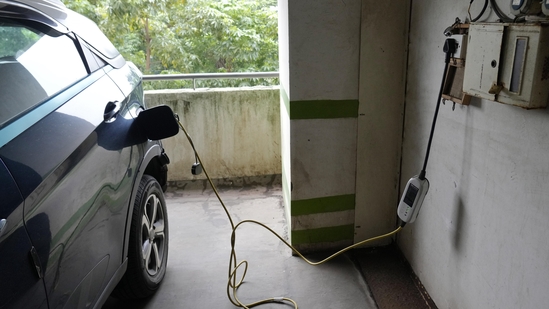Our Terms & Conditions | Our Privacy Policy
India’s flagship EV policy: Everything you need to know about it | Latest News India
In a bid to attract global EV makers, India has finally rolled out its flagship EV policy. While on the lines of the policy proposed in March 2024, the new flagship policy comes with quite a few more details that paint a clearer picture.
A car gets charged at an electric vehicle charging station at a residential building parking area in Mumbai.(AP File)
According to the Central Government, the policy will allow global car manufacturers to import a limited number of EVs into the country at a slashed customs duty of 15% as opposed to the 70-110% import duty currently imposed on foreign carmakers. As mentioned earlier, the policy applies to cars costing $35,000 ( ₹30 lakh) or less, and requires the carmaker to pledge an investment of ₹4,100 crore ($486 million) to manufacture EVs locally. The investment now has to be made within three years of getting approval from the government. Local manufacturing should also commence within this period, according to guidelines.
At present, the policy allows a brand to import up to 8000 units in a single year, allowing the manufacturer to carry over unutilised import capacity to the next year, if need be. Then there are the changes made to tighten the eligibility criteria.
To be eligible to apply, a consortium of companies must have a minimum annual revenue of ₹10,000 crore from automotive manufacturing and at least ₹3,000 crore in fixed assets. Companies must achieve at least 25% domestic value addition within three years and increase it to 50% within five years. The investment will also only take into account expenses on R&D, new plant, machinery and equipment and not land costs. Even the building and charging infrastructure costs are to account for only 10% and 5%, respectively, of the overall investment.
According to the guidelines issued, the application window will open shortly and will remain open for a minimum period of 120 days. However, depending on the response from global manufacturers, the window might be reopened at any point before March 15, 2026.
Who is likely to benefit? What about Tesla?
Not Tesla, for starters, as Minister of Heavy Industries and Public Enterprise HD Kumaraswamy clarified that the American EV giant is unlikely to set up shop in India any time soon, despite rumours stating otherwise. While Tesla has begun scouting locations for showrooms, it will most likely sell imported cars at full import duty, and not manufacture locally.
Among the many reasons is that the demand for Tesla cars primarily comes from a segment of consumers who are affluent and purchasing the cars purely for the brand value. However, it’s a brand value that has diminished considerably in American and European markets. But Tesla cannot thrive without a dedicated supercharger network, and the investment required to set up such a network in India, is one that Tesla has shown no interest in making.
For domestic carmakers, it is likely to increase competition although with giants like BYD – the only global EV manufacturing outfit with the chops to outshine Tesla – still facing entry barriers, the competition isn’t likely to intensify considerably. Kumaraswamy said the policy aims to strengthen local EV manufacturing competency, and fulfill India’s larger goal towards being a net-zero emissions country by 2070.
The government suggested caution about who it allows to invest and at present, BYD appears to be out of the fray. With both Tesla and BYD out, this will likely slow down the influx of third-party component and supply chain players, whose expertise was expected to boost EV growth in the country.
Given the stringent conditions for domestic manufacturing, EV makers aren’t expected to rush towards making an investment although the government has indicated that existing players like Mercedes-Benz, Volkswagen India, Hyundai etc are keen to manufacture in the country. Another brand which is already set to complete the setting-up of a plant is Vietnamese EV brand Vinfast.
However, with mounting losses, lacklustre brand equity and premium pricing VinFast isn’t expected to increase EV market penetration by a considerable margin or prove to be a threat to local manufacturers who continue to remain steadfast in the opposition of lowering duty barriers.
Images are for reference only.Images and contents gathered automatic from google or 3rd party sources.All rights on the images and contents are with their legal original owners.



Comments are closed.